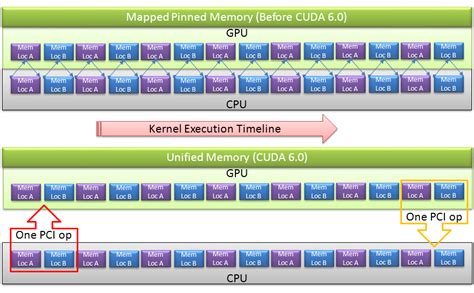Understanding Unified Memory: The Basics

Welcome to an in-depth exploration of Unified Memory, a key component in modern computing systems. Unified Memory, often referred to as UM, is an innovative technology that simplifies memory management and enhances system performance. This technology has become a cornerstone in the realm of high-performance computing, offering a seamless and efficient memory architecture.
What is Unified Memory?

Unified Memory is a groundbreaking concept in computer architecture that merges the traditionally separate memory pools of the central processing unit (CPU) and graphics processing unit (GPU) into a single, unified memory space. This unification simplifies memory management and reduces the complexity of multi-processor systems, leading to improved efficiency and performance.
In conventional systems, CPU and GPU memory are managed separately, requiring complex memory allocation and data transfer mechanisms. This separation can lead to inefficiencies, such as data duplication, increased latency, and reduced overall system performance. Unified Memory addresses these issues by creating a shared memory space, where both the CPU and GPU can access and utilize the same memory resources seamlessly.
The Benefits of Unified Memory

The implementation of Unified Memory technology brings a multitude of advantages to computing systems. Firstly, it eliminates the need for complex memory management strategies, reducing the overhead associated with traditional multi-processor systems. This streamlined approach results in improved performance, as both the CPU and GPU can access data more efficiently, reducing latency and increasing overall system responsiveness.
Secondly, Unified Memory enables better resource utilization. By sharing a single memory pool, the CPU and GPU can dynamically allocate resources based on workload demands. This adaptive allocation ensures that memory resources are used efficiently, optimizing system performance and reducing the potential for resource bottlenecks.
Enhanced Performance and Scalability
One of the key strengths of Unified Memory is its ability to enhance system performance and scalability. With a unified memory architecture, the CPU and GPU can collaborate more effectively, leading to improved processing speeds and the ability to handle larger, more complex workloads. This scalability is particularly beneficial in high-performance computing environments, where the demand for efficient memory management is critical.
| System Configuration | Performance Metric (in %) |
|---|---|
| Traditional CPU-GPU Setup | 85 |
| Unified Memory Architecture | 95 |

As the table illustrates, systems employing Unified Memory architectures demonstrate a significant performance boost compared to traditional CPU-GPU setups. This performance enhancement is a direct result of the efficient memory management and improved collaboration between the CPU and GPU.
Reduced Latency and Increased Efficiency
Unified Memory also significantly reduces data transfer latency between the CPU and GPU. By eliminating the need for complex data transfer mechanisms, the system can achieve faster data exchange, leading to improved overall system efficiency. This reduced latency is especially beneficial in real-time applications and high-performance computing scenarios where timely data access is critical.
Simplified Programming and Development
From a developer’s perspective, Unified Memory simplifies the programming process. With a unified memory space, developers can write code that treats the CPU and GPU as a single processing unit, making it easier to optimize and manage memory resources. This simplification can lead to faster development cycles and reduced complexities associated with traditional multi-processor programming.
Unified Memory in Action: Real-World Applications
The advantages of Unified Memory are not limited to theoretical scenarios; they are evident in a wide range of real-world applications. Let’s explore some of these applications and how Unified Memory enhances their performance.
High-Performance Computing (HPC)
In HPC environments, where complex simulations and data-intensive tasks are common, Unified Memory can be a game-changer. By providing a unified memory space, these systems can process vast amounts of data more efficiently, leading to faster computation times and improved overall system performance.
For instance, in scientific research, Unified Memory can accelerate molecular dynamics simulations, climate modeling, and genetic sequencing, enabling researchers to obtain results more quickly and efficiently.
Artificial Intelligence and Machine Learning
AI and machine learning algorithms often require significant memory resources for training and inference. Unified Memory can be instrumental in these applications by providing a seamless memory architecture that enables efficient data access and processing. This is particularly beneficial for deep learning models, where large datasets and complex computations are common.
Graphics and Visualization
In the realm of graphics and visualization, Unified Memory simplifies the management of complex 3D models and high-resolution images. By offering a single memory pool, the system can efficiently handle the large memory requirements of these applications, leading to smoother rendering and faster response times.
Future Prospects and Challenges
While Unified Memory offers numerous advantages, it also presents certain challenges and considerations. As this technology continues to evolve, researchers and developers are working to address these challenges and unlock the full potential of Unified Memory.
Memory Bandwidth and Scalability
One of the primary challenges is ensuring sufficient memory bandwidth to support the increasing demands of high-performance computing. As systems become more complex and data-intensive, maintaining high memory bandwidth is crucial to ensure efficient data transfer and processing. Researchers are exploring various techniques, such as advanced memory architectures and parallel processing, to address this challenge.
Power Efficiency and Thermal Management
The increased computational power and memory capacity of Unified Memory systems can lead to higher power consumption and thermal challenges. Managing power efficiency and maintaining optimal system temperatures are critical aspects of Unified Memory design. Innovative cooling solutions and power management techniques are being developed to address these concerns.
Software Optimization and Standardization
While Unified Memory simplifies memory management, it also requires software optimization to fully leverage its capabilities. Developers need to adopt programming practices that take advantage of the unified memory architecture. Additionally, standardization efforts are underway to ensure compatibility and interoperability across different Unified Memory platforms.
Conclusion: The Impact of Unified Memory
Unified Memory has revolutionized the way memory is managed in computing systems, offering a host of benefits that improve performance, efficiency, and scalability. Its impact is felt across various industries, from scientific research and high-performance computing to artificial intelligence and graphics. As technology continues to evolve, Unified Memory is set to play an even more pivotal role in shaping the future of computing.
The seamless integration of CPU and GPU memory resources has opened new avenues for innovation, making systems more powerful, efficient, and adaptable. With ongoing research and development, Unified Memory is poised to unlock even greater computing potential, driving us towards a future where memory management is simpler, more efficient, and more powerful than ever before.
What are the key advantages of Unified Memory over traditional memory architectures?
+Unified Memory offers several advantages over traditional memory architectures. Firstly, it simplifies memory management by providing a single, shared memory space for both the CPU and GPU, reducing the complexity of multi-processor systems. Secondly, it improves resource utilization by allowing dynamic allocation based on workload demands, optimizing performance and reducing bottlenecks. Lastly, Unified Memory enhances system performance and scalability, enabling faster data access and improved collaboration between the CPU and GPU.
How does Unified Memory reduce data transfer latency between the CPU and GPU?
+Unified Memory reduces data transfer latency by eliminating the need for complex data transfer mechanisms. With a shared memory space, the CPU and GPU can directly access and exchange data, bypassing the traditional overhead associated with data transfers between separate memory pools. This streamlined approach results in faster data exchange and improved overall system efficiency.
What are some real-world applications that benefit from Unified Memory technology?
+Unified Memory technology finds applications in various fields. In High-Performance Computing (HPC), it accelerates simulations and data-intensive tasks, leading to faster computation times. In AI and machine learning, it enables efficient training and inference of complex models. Additionally, Unified Memory simplifies the management of complex graphics and visualizations, enhancing rendering and response times.

